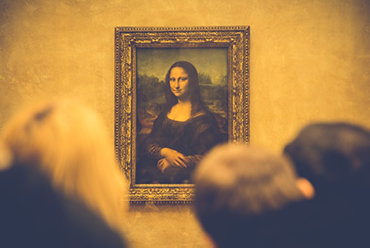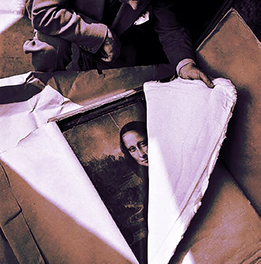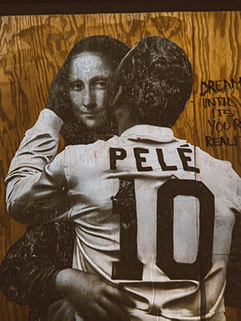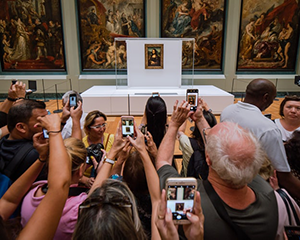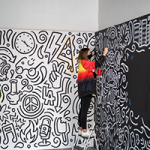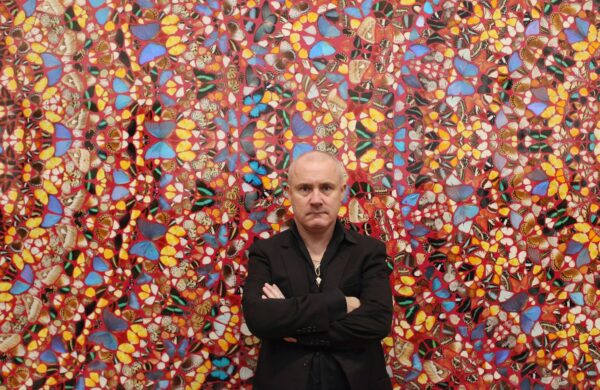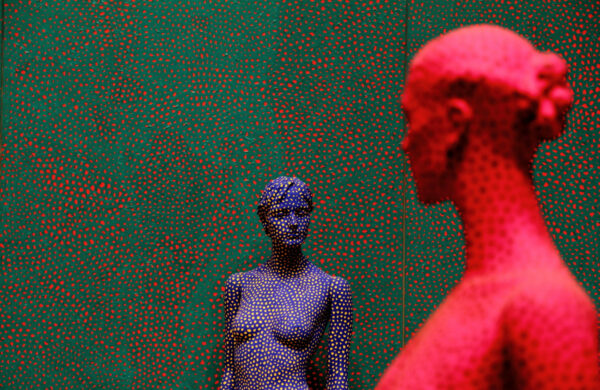The Mona Lisa: What Makes it a Masterpiece?
The Mona Lisa is arguably the most recognizable piece of art in the world. But, what makes Mona Lisa a Masterpiece?
Her enigmatic smile,- despite being debated continuously amongst historians and art scholars, there’s still great speculation about the identity and the meaning behind da Vinci’s painting.
Enthusiasts come from everywhere around the world just to see her. Thousands of visitors line up daily to take a look at the masterpiece that has been carefully kept for centuries.
There are many reasons for her fame that make up for an interesting story and help explain her enduring popularity. To understand why this work remains iconic after so many years, we have to look at its mysterious origins, groundbreaking art techniques and the influence it still has on other artists and art movements.
So, what is behind that ambiguous smile? Today I will be breaking down and analysing what makes the Mona Lisa a Masterpiece.
Historic Context: Where Does She Come From
Leonardo da Vinci, the Italian polymath and multidisciplinary artist from the Renaissance era who created some of the world’s most iconic works, painted the Mona Lisa over several years during a large period of his life.
da Vinci should have completed the Mona Lisa around 1503. However, records show that the artist kept on working on the painting after 1503, and probably didn’t finish until he died in 1519. When da Vinci left Italy to become King Francis I’s protégé, he took the Mona Lisa with him. Right before da Vinci died, he sold what was to be considered the biggest masterpiece on earth, to King Francis for 4,000 gold coins.
Since then, the iconic painting has been passed on to the hands of kings, presidents, museums and private collectors, – from Louis XIV to Napolean Bonaparte.
She’s finally found a permanent home now. This enigmatic figure has been under Louvre’s protection for decades now, where she currently remains after a dispute between the U.S. President John F. Kennedy and the rest of Europe claiming the masterpiece as a heritage symbol.
The origin behind her name comes from what’s thought to be a portrait of Lisa Gherardini, wife of an Italian silk merchant named Francesco del Giocondo. Mona Lisa’s alternative name is La Gioconda due to who it was commissioned to.
But here’s where things get complicated now: apparently yes, – Mona Lisa is a commissioned portrait of Giocondo’s wife Lisa. And I do believe in that.
However, speculation surrounding the iconic piece suggests that the Mona Lisa is just a feminized version of Leonardo da Vinci himself… But I will dive into that later on, so you might as well keep reading!
Techniques
To create a masterpiece you have to be a master yourself. And Leonardo da Vinci was an absolute genius. Drawing, painting, sculpting, da Vinci was also an engineer, a scientist, an architect and a theorist,- a man of many talents you may say.
Through a series of innovations in technique and practice, which are still taught to this day, this Italian polymath has revolutionized the art world when he painted the Mona Lisa.
Unlike other paintings of the 16th century, the Mona Lisa is a very realistic portrait of a real person. Scholars have attributed this sort of accomplishment due to the artist’s brush and colour blending skills. Mona Lisa’s softly sculpted face shows how innovative da Vinci was in regards to exploring new techniques.
Sfumato was one of them, you can see that da Vinci utilizes light and shadows to model form in a way that reveals the skull below the skin. The veil delicately painted, the hair finely worked on, and the fabric carefully rendered all show intense careful observation.
In addition to its incredible technicalities, the woman’s soft smile is incredibly alluring. There’s also a thing called the Mona Lisa Effect: The resonance of her facial expression depends on the angle from which the viewer approaches it. From one viewpoint she looks cheerful and happy; and from another one, for some viewers, it is difficult to tell if she is simply smiling or not at all.
Although the Mona Lisa Effect is revolutionary by itself, she is also the earliest Italian portrait to include a full-length figure with arms. She is shown resting against a column staring out into the horizon behind her. The picture frame lies on the columns and creates a window effect that looks out over both distance and foreground.
Her Unique Face and Smile
As I said just now, her expressionless gaze can follow you around the room. And her powerful stare continues to captivate all who encounter her.
After 500 years of enduring those who have let themselves be lost in contemplation of her mocking smile, the Mona Lisa still maintains intense eye contact with everyone that lets themselves be absorbed by her image. I have to admit, I’ve been to the Louvre before just to see her and it made me feel uneasy, to say the least…
Art historians have proposed numerous theories for the fascination with Mona Lisa. Most medical hypotheses examine dental problems, facial paralysis and even thyroid issues as evidence of her captivating face.
One theory explaining the Mona Lisa’s smile hinges on entertainers who would have made the model laugh during the painting process, allowing Leonardo da Vinci to capture this unique and slightly stifled smile.
It is also rumoured that there are secrets and hidden symbols behind her alluring expression. The buzzing masterpiece is still a hot topic of discussion when it comes to who the model actually is.
With theories suggesting that the iconic woman could be inspired by random Italians posing for da Vinci, including da Vinci himself. But, despite these side theories, a note written by Agostino Vespucci in 1503, indicated that Leonardo da Vinci told him he was working on a painting to the wife of Giocondo, who commissioned the piece.
Art historians generally agree that Mona Lisa is actually Giocondo’s wife.
Scholars have also speculated that Leonardo created more than one version of the Mona Lisa. In addition to the original commissioned by Gherardini del Giocondo, there is a second version painted in 1513 and believed to be commissioned by Giuliano de Medici. The latter is said to be exhibited at the Louvre.
Becoming an Icon
Due to Mona Lisa’s ambiguous gaze and mysterious face, this timeless masterpiece has been the subject of mocking, idolization, deep analysis and studies, commercial appropriation and meme culture content. People have adopted her as an international symbol of the arts. Her inconspicuous origin has been a discussed theme that has been buzzing for decades.
Mona Lisa is one of the most copied and reproduced paintings in the world. Since its creation, artists have appropriated her image, from Leonardo’s contemporaries to modern painters.
Duchamp took a postcard of the Mona Lisa and added a moustache and goatee. Artists like Warhol, Dali, Basquiat and Banksy have made their own interpretations of her in a variety of styles, including painting her as a dinosaur, unicorn, and even sporting sunglasses and Mickey Mouse ears.
What Really Made the Mona Lisa a Masterpiece
Despite all the theories, speculation, mockery and idolization behind this iconic figure, what turned the highly valuable piece into a Masterpiece was more than just the revolutionary art techniques.
For centuries, the Mona Lisa hung quietly in the Louvre. But, on August 21, 1911, Mona Lisa was stolen right off of the museum’s wall during a heist, shooking up the art world.
Suspicions were widespread as the Louvre shut for a week so investigators could collect pieces of the puzzle. Initially, conspiracy theories abounded, claiming that it was all a publicity stunt orchestrated by the Louvre or perhaps Pablo Picasso had taken it.
After more than two years, an Italian carpenter working at the Louvre back in 1913 was accused of stealing the Mona Lisa from a Florentine art dealer who received information that it was out there. The French police found Vincenzo Peruggia, who admitted he had stolen the painting to duplicate it and resell it, claiming it belonged in an Italian museum rather than a French one.
From the day that Mona Lisa was returned to the Louvre, it didn’t take long for people from all around the world to make pilgrimages and admire her genius.
Since then, the masterpiece has been subject to various attacks. She has suffered an acid attack, a rock being thrown at her and a clay mug too. Who would’ve thought such an enigmatic and mysterious work would cause such a ruckus…
But there you have it. Due to all the hype and the interest, the several cultural resets it has accompanied, the artistic techniques it has shaped and the overwhelming buzz it has made, the Mona Lisa is indeed a masterpiece for all its history, – not just because of its genius, but because it has had an impact in so many different settings and social contexts.
Curiosities
- The Mona Lisa is valued at $100 million. With inflation, this work of art would cost more than $867 million as of January 2021.
- The painting measures just about 77 cm x 53 cm.
- Because of it being stolen and a victim to multiple attacks, the painting is now housed behind a bulletproof glass to protect her from vandals.
Conclusion
- The Mona Lisa is a painting made by Leonardo da Vinci. It’s thought to be a portrait of Lisa Gherardini, wife of an Italian silk merchant named Francesco del Giocondo.
- Unlike other paintings of the 16th century, the Mona Lisa is a very realistic portrait of a real person. Scholars have attributed this sort of accomplishment due to his brush and colour blending skills called sfumato.
- The Mona Lisa Effect: From one viewpoint she looks cheerful and happy; and from another, for some viewers, it is difficult to tell if she is simply smiling or not at all.
- It is also rumoured that there are secrets and hidden symbols behind her alluring expression. The buzzing masterpiece is still a hot topic of discussion when it comes to who the model actually is. One theory believes it’s a feminized self-portrait of da Vinci.
- Due to Mona Lisa’s ambiguous gaze and mysterious face, this timeless masterpiece has been the subject of mocking, idolization, deep analysis and studies, commercial appropriation and meme culture content. People have adopted her as an international symbol of the arts.
- Mona Lisa is one of the most copied and reproduced paintings in the world.
- Despite all the theories, speculation, mockery and idolization behind this iconic figure, what turned the highly valuable piece into a Masterpiece was more than just the revolutionary art techniques.
- The masterpiece has been subject to various attacks and scandalous theft. She has suffered an acid attack, a rock being thrown at her and a clay mug too.
- The Mona Lisa is indeed a masterpiece for all its history, – not just because of its genius, but because it has had an impact in so many different settings and social contexts.
